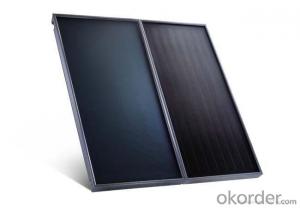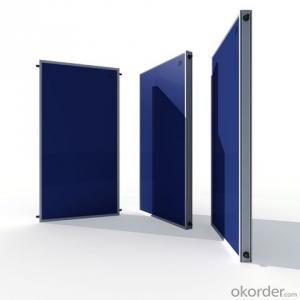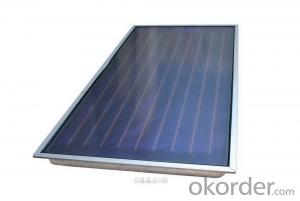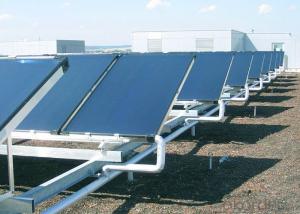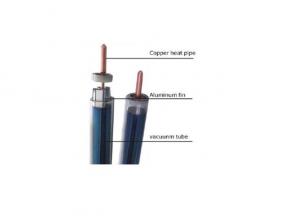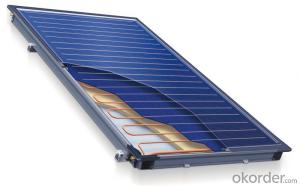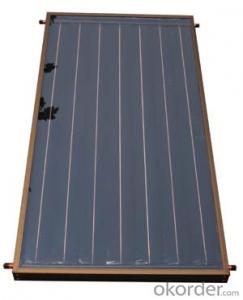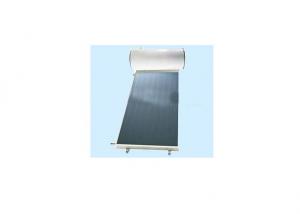Solar Thermal Application and Glass Pipe Material solar thermal collector
- Loading Port:
- Shanghai
- Payment Terms:
- TT OR LC
- Min Order Qty:
- 500 pc
- Supply Capability:
- 10000 pc/month
OKorder Service Pledge
OKorder Financial Service
You Might Also Like
Specification of flat plate solar collector:
1) Low iron textured tempered glass(3.2mm thickness)offers the best capability of durability, strength.
2) Tinox blue titanium or black chrome coating have very high absoption rate to ensure the high efficiency.
3) Whole-plate ultrasonic welding technology makes the flate plate solar collector more beautiful, efficient and durable.
4) Special Anodized aluminum alloy frame to ensure handsome appearance and can accept high pressure without leakage.
These top-of-the-range solar panel heat collectors are suitable for heating domestic hot water, swimming pools etc - even in winter! One unit is adequate for an average household (3-4people), and it is modular, so you can add more if required. A single panel is sufficient for a 200litre cylinder, but you can fit 2 or more for high water usage, or for heating swimming pools or underfloor heating. Some types of renewable energy are only available in certain locations, however free solar heating is potentially available to almost every house in the world! "
Specification of flat panel solar collector
Flat plate collectors are an extension of the basic idea to place a collector in an 'oven'-like box. Here, a pipe is connected to the water tank and the water is circulated through this pipe and back into the tank. The water tank is now outside the collector that only contains the pipes. Since the surface-to-volume ratio increases sharply as the diameter of a pipe decreases, most flat-plate collectors have pipes less than 1 cm in diameter. The efficiency of the heating process is therefore sharply increased. The design of a flat-plate collector therefore typically takes the shape of a flat box with a robust glass top oriented towards the sun, enclosing a network of piping. In many flat-plate collectors the metal surface of the pipe is increased with flat metal flanges or even a large, flat metal plate to which the pipes are connected. Since the water in a flat-plate collector usually reaches temperatures much higher than that of an ICS, the problem of radiation of heat back to the environment is very important, even though a box-like 'oven' is used.
Description:
Flat-plate collector is one of common solar collectors for solar hot water heating in homes and solar space heatings. Flat plate solar collectors provide quality hot water with its new solar energy efficient flat plate design. This glazed collector includes a selective coating to maximize the solar heat absorption, weather resistant aluminium framing and interior fibreglass insulation for increased efficiency.
Features:
1) High efficiency solar collector using heat pipe evacuated tubes
2) Able to be used in all climates
3) Reliable and efficient with twin-glass solar tubes
4) Copper heat pipes for rapid heat transfer
5) Easy plug-in installation for mounting on the roof or at ground level
6) Maintenance free
7) Suitable for mains pressure water (up to 6bar / 87psi)
8) Corrosion resistant silver brazed copper header
9) Frame material: 304 2B grade standard steel
10) Casing material: 304 BA or AB stainless steel
11) Excellent insulator in glass wool
12) Collectors may be connected in series to increase water heating capacity
13) Tubes easily replaced if broken - can be used with broken tubes
14) Ideal for commercial solar water heating applications
- Q:Can solar collectors be used for heating museums and cultural centers?
- Yes, solar collectors can be used for heating museums and cultural centers. Solar thermal systems can capture the sun's energy and convert it into heat, which can then be used for space heating or water heating purposes in these buildings. This renewable energy source can provide a sustainable and cost-effective solution for heating while reducing greenhouse gas emissions. Additionally, solar collectors can be integrated into the architecture of these buildings without compromising their aesthetic value.
- Q:Can solar collectors be used in combination with greenhouses or indoor farming systems?
- Solar collectors, such as photovoltaic panels or solar thermal collectors, have the potential to be utilized alongside greenhouses or indoor farming systems. They offer a renewable energy source that can power various systems within these setups. Within greenhouses, solar collectors can generate electricity for different purposes. They can provide power for lighting, heating, ventilation, and irrigation systems. The electricity produced can ensure plants receive adequate artificial lighting during periods of low natural light, creating optimal growing conditions. Moreover, it can maintain desired temperature levels through heating systems, especially during colder months. Additionally, solar collectors can power ventilation fans and systems, promoting proper air circulation and preventing the buildup of excessive humidity or carbon dioxide. They can also be utilized to power irrigation systems, promoting efficient watering of crops and minimizing water waste. In indoor farming systems, solar collectors can also make a significant impact. By harnessing solar energy, indoor farms can reduce their reliance on traditional energy sources and decrease their carbon footprint. Solar collectors can provide electricity to power LED lights, which simulate natural sunlight and optimize plant growth. They can also be used for heating and cooling systems to maintain an ideal temperature for crops. Additionally, solar collectors can power ventilation systems, ensuring proper air exchange within the controlled environment. Overall, the integration of solar collectors with greenhouses or indoor farming systems offers numerous benefits. It enhances sustainability, reduces energy costs, and promotes environmentally friendly agricultural practices. By utilizing renewable energy, these systems contribute to a more sustainable and efficient approach to farming, reducing reliance on fossil fuels and mitigating the environmental impact of traditional energy sources.
- Q:What is the cost of installing a solar collector?
- The cost of installing a solar collector can vary depending on various factors such as the size and type of collector, the complexity of the installation, the location, and any additional equipment or accessories needed. On average, the cost can range from several thousand to tens of thousands of dollars. It is best to consult with a professional solar installer to get an accurate estimate based on your specific requirements and circumstances.
- Q:How much do solar collectors cost?
- The cost of solar collectors can vary depending on various factors such as the size of the system, the type of collectors used, and the specific requirements of the installation. On average, the cost of a solar collector system can range from $5,000 to $20,000. This includes the cost of the collectors, installation, and any necessary additional components such as storage tanks or pumps. It's important to note that while there is an upfront cost, solar collectors can provide significant long-term savings on energy bills and may also be eligible for government incentives or tax credits, further reducing the overall cost of the system. Additionally, the cost of solar collectors has been decreasing over the years due to advancements in technology and increased market competition, making them a more affordable and accessible option for homeowners and businesses.
- Q:Can solar collectors be used for generating electricity in forests?
- Yes, solar collectors can be used for generating electricity in forests. However, the efficiency of solar collectors may be affected by the shading caused by trees and foliage. It is important to carefully consider the location and positioning of solar collectors to maximize sunlight exposure and optimize electricity generation in forested areas.
- Q:Can solar collectors be used for heating swimming pools in warm climates?
- Yes, solar collectors can definitely be used for heating swimming pools in warm climates. The abundant sunlight in warm climates makes solar energy an excellent and efficient option for heating pool water. Solar collectors capture the sun's energy and transfer it to the pool water, providing a cost-effective and environmentally friendly solution for pool heating in these regions.
- Q:Can solar collectors be used to generate electricity during nighttime hours?
- Generating electricity using solar collectors is not possible during nighttime hours. The reason for this is that solar collectors depend on sunlight to convert it into usable energy. Since there is no sunlight at night, the solar collectors lack the necessary source of energy to generate electricity. Nevertheless, other options exist to produce electricity during nighttime hours. One such method involves utilizing batteries to store surplus solar energy generated during daylight hours for later utilization.
- Q:What is the average cost of a solar collector system?
- The average cost of a solar collector system can vary depending on various factors such as the size of the system, type of collectors used, installation costs, and location. However, on average, a solar collector system can cost anywhere from $10,000 to $30,000.
- Q:Can solar collectors be used in solar thermal cooling?
- Solar thermal cooling systems have the ability to utilize solar collectors for their operation. These collectors, such as flat plate or evacuated tube collectors, capture the sun's radiation and convert it into heat energy. This heat energy can then be utilized to power a thermally-driven cooling system like an absorption or adsorption chiller. When implementing a solar thermal cooling system, the solar collectors are typically connected to a heat transfer fluid, which can be water or a specialized fluid. This fluid absorbs the heat from the sun and is subsequently employed to drive the cooling process in the chiller system. The chiller system, powered by the solar collectors, effectively cools the air or fluid utilized in the cooling system. The use of solar collectors in solar thermal cooling systems results in reduced or eliminated reliance on traditional electricity for cooling purposes. This leads to significant energy and cost savings. Moreover, solar thermal cooling systems have lower greenhouse gas emissions compared to conventional cooling systems, making them an environmentally friendly option. However, it is important to consider that solar thermal cooling systems may have limitations in terms of their cooling capacity. Additionally, they require sufficient sunlight to operate optimally. Factors such as system design, climate conditions, and energy storage solutions must also be taken into account to effectively utilize solar collectors in solar thermal cooling.
- Q:What is the impact of temperature variations on the performance of solar collectors?
- Temperature variations can have a significant impact on the performance of solar collectors. Solar collectors are designed to absorb sunlight and convert it into usable energy, typically in the form of heat or electricity. The temperature of the collector itself, as well as the ambient temperature, can affect the efficiency and overall output of the system. One key factor affected by temperature variations is the thermal efficiency of the solar collector. As the temperature increases, the efficiency of the collector usually decreases. This is mainly due to the increase in thermal losses, such as conduction and radiation losses. Higher temperatures can result in increased heat transfer to the surroundings, reducing the amount of energy that can be captured and utilized. Another aspect impacted by temperature variations is the efficiency of the photovoltaic (PV) cells in solar collectors that generate electricity. PV cells typically have a negative temperature coefficient, meaning their efficiency decreases as the temperature rises. This is because higher temperatures can lead to an increase in electron excitation and leakage, reducing the electrical output of the cells. Therefore, temperature control and cooling mechanisms are often employed to maintain optimal operating conditions for PV cells. Furthermore, temperature variations can affect the overall lifespan and durability of solar collectors. Excessive heat can cause thermal stress and degradation of materials, leading to reduced performance and potential failures over time. On the other hand, extremely low temperatures can also impact the performance, as they can freeze the working fluid or cause damage to pipes and components. It is important to note that the impact of temperature variations on solar collector performance can be mitigated through proper design, insulation, and control systems. For instance, implementing insulation measures can minimize thermal losses, while temperature control systems can regulate the operating conditions within an optimal range. In conclusion, temperature variations play a crucial role in shaping the performance of solar collectors. The efficiency, output, and durability of solar collectors are influenced by the temperature of the collector itself and the ambient conditions. Understanding and effectively managing temperature variations are essential for maximizing the energy output and longevity of solar collector systems.
1. Manufacturer Overview |
|
|---|---|
| Location | |
| Year Established | |
| Annual Output Value | |
| Main Markets | |
| Company Certifications | |
2. Manufacturer Certificates |
|
|---|---|
| a) Certification Name | |
| Range | |
| Reference | |
| Validity Period | |
3. Manufacturer Capability |
|
|---|---|
| a)Trade Capacity | |
| Nearest Port | |
| Export Percentage | |
| No.of Employees in Trade Department | |
| Language Spoken: | |
| b)Factory Information | |
| Factory Size: | |
| No. of Production Lines | |
| Contract Manufacturing | |
| Product Price Range | |
Send your message to us
Solar Thermal Application and Glass Pipe Material solar thermal collector
- Loading Port:
- Shanghai
- Payment Terms:
- TT OR LC
- Min Order Qty:
- 500 pc
- Supply Capability:
- 10000 pc/month
OKorder Service Pledge
OKorder Financial Service
Similar products
New products
Hot products
Hot Searches
Related keywords
